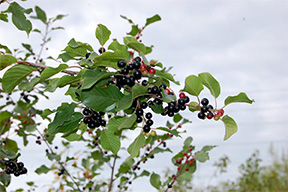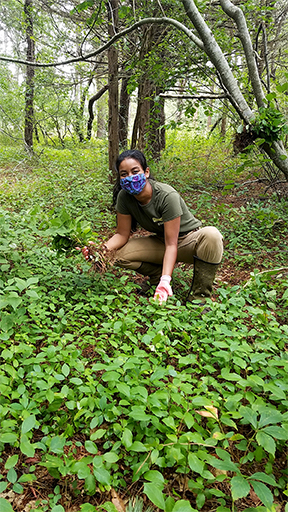By Kate Feiffer
To help Sheriff’s Meadow Foundation supporters identify invasive species and to learn about what SMF is doing to control their spread, the SMF newsletter has been running a series of articles focused on invasive species found on the Vineyard.
Glossy buckthorn, Frangula alnus

Photo by Eli-Sagor
It’s not known exactly when glossy buckthorn also known as alder buckthorn and breaking buckthorn, and classified as Frangula alnus, arrived on the Vineyard. SMF’s Director of Stewardship Kristen Geagan first noticed glossy buckthorn growing on the Island some fifteen years ago.
Since that time the plant has settled in and stretched out. Land Steward Liz Loucks has found it growing in Sheriff’s Meadow Sanctuary and elsewhere on the Island. Naturalist Margaret Curtin has spotted glossy buckthorn in Sengekontacket, around Crystal Lake and the Farm Pond Preserve, both in Oak Bluffs, the Mill Brook in West Tisbury, and in the Manuel F. Correllus State Forest. (Curtin is working with Greg Palermo, and Polly Hill Arboretum, as well as other conservation minded groups and individuals, to update “The Flora of Martha’s Vineyard,” first published in 1997 by Debra Swanson and Carol Knapp.)
Glossy buckthorn is native to Europe, northern Africa, and central Asia and was brought to the United States over two centuries ago. As with many imported plants, it became fashionable as an ornamental plant, no doubt because of its delicate creamy-colored flowers and bright berries, and also because its beauty was matched by its usefulness as a natural barrier.
If you’re out trying to find this invasive, don’t be deceived by its name. Glossy buckthorn does not have thorns; it does, however, have glossy leaves. A more technical description can be found in “Gray’s Manual of Botany”—“The short, oblong to obovate leaves are 3-7 cm (1-2.5 in.) long and are arranged alternately. They are dark green (in the summer) and shining above, and glabrous or slightly pubescent beneath.”
During the summer months, glossy buckthorn blooms with delicate five-petalled flowers and boasts berries—once used as a diuretic, but now considered best not to ingest—that can be green, red, or purple. Glossy buckthorn is deciduous, and can grow up to twenty feet high or can show up like a shrub. It thrives in wooded areas as well as wetlands. It appreciates the sun but manages in the shade, and because it can grow in as a matted mess, it snatches sunlight away from other species in need, which can be ecologically catastrophic.

Lia Potter pulling out glossy buckthorn
A dive into the history of glossy buckthorn reveals some confusion, due to the fact that the plant was originally designated as Rhamnus frangula, but was then changed to Frangula alnus. What is known is that the plant has been used to make paint—sap green—and gunpowder. Notably, the British inventor and military man Sir William Congreve (1772-1828), distinguished for designing the Congreve rocket which was used in the Napoleonic Wars and the War of 1812, found that the charcoal milled from glossy buckthorn made powerful gunpowder.
In the United States, glossy buckthorn had become an issue of concern by the mid-twentieth century. It was described as “rapidly spreading” and “likely to become obnoxious” in the 1950 edition of “Gray’s Manual of Botany.” More recently, the “Invasive Plant Atlas of New England” warned: “Frangula alnus is a great threat to wetlands, where it can form dense stands that cause the growth of other species to be suppressed. It is readily dispersed by birds, and the extended productivity of the fruits allows it to be dispersed throughout the summer and fall. It is also an alternative host to crown rust fungi that infects oats.”
Glossy buckthorn is on the Massachusetts invasive plant list. It cannot be sold or distributed in the state. And yet, like many non-native invasives, it thrives. Since birds distribute the berries, the plant can jump from one spot to another with ease. Management of glossy buckthorn can be obtained by pulling and digging out the plant or by cutting it. For the plants found at Sheriff’s Meadow Sanctuary, “We have been pulling seedlings and saplings. When the soil is damp and soft after a rain we have found them easier to pull than other species and they have distinctive maroon-red roots, leaving no doubt that a glossy buckthorn seedling has been pulled,” says Liz Loucks.

